|
|
Welcome to my travel log! You will find here a lot more than in the travel reports, stripped from political correctness. Enjoy! 
Dec 29, 2004 07:00 PM Mali - Mopti to Hombori
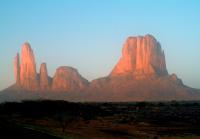 I am not sure why, but I decided to visit the bank in Mopti to see if I could withdraw some more money, just in case. Since I was travelling in the CFA region until the end of my holiday, there was no risk that I over draw or could not change it back to euro, for example.
I am not sure why, but I decided to visit the bank in Mopti to see if I could withdraw some more money, just in case. Since I was travelling in the CFA region until the end of my holiday, there was no risk that I over draw or could not change it back to euro, for example.
I expected the procedure to take some time, so I said to my guide and driver to pick me up at 7:30 in the morning, so we could be in the bank right after their open. There was a long way before us that day, so I wanted to set out early in order to reach our destination well before the sunset.
Van and Ali were late more than an hour, but, although reluctantly, I decided to go the bank anyway, to show them what impact their delay makes on our trip.
The bank was very slow. It took two hours to complete the transaction despite the fact that it was an online and automated transaction on a standard credit card terminal.
Instead of 8:30 am, we departed Mopti at 11:30 am. It was a significant delay. In that time, we could have travelled almost 200 kilometres. But hey, this is Africa and it is like that. I actually did not care much but I knew that it made Ali, the driver, worried that if anything happened, we would need to travel in the hours of darkness, which is not advisable in Africa.
Fortunately, nothing happened on the way, and we arrived at the destination well before sunset. The road was straight, but in an appalling condition, making it rather hard.
Mali’s most picturesque landscape almost escaped me due to a lack of time. I knew about spectacular scenery in the western part of the country on the verge of the Sahara, but I did not specifically planned to visit it because I did not have enough time to visit everything in Mali. Since I made most of the planning well in advance, I forgot that Hombori was one of the options at the very beginning. When I had to change plans after having been mislead that I could not go to Timbuktu, I did not automatically choose Hombori as an alternative.
He old village of Hombori is situated on the cliff, from the top of which a magnificent view makes a perfect background for a picnic. Since I arrived rather late, as the sun was setting behind the mountains and other cliffs, I had only some time to visit the village.
The village is rather special, since the majority of the houses are built of stone, which is unusual in this part of the world. The chief's massive house made an impression on me. It actually looked like a palace, which could hold several families. It makes an incredible contrast to all surrounding small households. I was wondering whether the chief’s son becomes a chief or whether the village elects its chief and therefore allowing just anyone elected living in this vast compound.
My presence there on the cliff was sensational. I was told that many people refrain from going down to the new Hombori where they would have a chance to occasionally see some white tourists. Instead, I was left to deal with what I encountered. The people looked at me like I was from another planet (which I believe could actually be very true) and their reaction varied from extreme shyness to curiosity to disapproving me being there among them.
The kids again were the most friendly bods. They all wanted to hold my hand and follow me around the village occasionally smudging my camera lens. Bloody good job I have been using a neutral filter. At a time, I had my both hands busy holding to (or actually trying to hold) three children at each hand. It was making the navigation around very narrow, and sometimes steep and slippery, streets extremely challenging. I just could not fit there with my extra baggage.
Hombori is set around sandstone table mountains whose various forms make the area the Monument Valley of Mali. Some of the rocks and the landscape do really resemble the ones in Arizona and Utah, USA. The comparison, used in many publications, is therefore very accurate and fully justified. There is simply no question about it. The area is strikingly and exceptionally magnificent and the sandstone formations make it a marvellous landscape to travel through.
When the sandstone massive begins to appear, it is still about two hours drive to the village of Hombori. That is a great ride. The tall pinnacles and rocks stand in a distance on the vast plateau and if the desert dust had not been disturbing the clarity of the air, the views would have been really awesome.
Even though it was a bit more difficult to appreciate the scenery, which was so badly obscured, the dust cover was making the adventure more dramatic. The remote silhouettes of the nature’s sculptures were adding some spice to the anticipation of how they actually looked from up close.
And a particular one of them is dubbed Five Fingers of Fatima or, as other sources inaccurately state, La Main de Fatima (The Hand of Fatima), which is a religious term that should not be used. Although, I would like to argue, as always, that neither of the terms used is accurate, since there are actually just three fingers, if you contend that the middle fingers are actually kept together.
It is arguably the most recognised and most photographed rock formation in Mali. It is 600 metres tall and it is so close to the road that as one approaches it, it rises and rises and rises.
The Five Fingers of Fatima are also a technical climbing centre with several challenging climbing paths, most of which are rated using the international scale to describe the technical difficulty of rock climbing routes.
I did not see anyone climbing the rocks at the time I was visiting. Not even Tom Cruise!
Going to Hombori, I thought that Van made a booking at one of the basic hotels or camping sites, but he did not. This was yet another disappointment.
As it happens, none of the listed hotels and camping sites in Hombori had room that night, and the situation was becoming quite hot. Fortunately, there was another, quite new, establishment nearby, which had space.
It was a rustic camping site offering five or six very basic rooms, some with mosquito nets. They were made of mud brick and the door was a sheet of corrugate iron, which could be locked with a padlock. No electricity in the morning.
The camping had a restaurant offering simple dishes like fried chicken with chips and green peas, but the much better option is couscous with meat sauce. The restaurant has extremely slow service, the slowest I encountered in West Africa.
Maybe there is a trick in this, though. Their chicken was so badly undercooked that the flesh was painfully sticking to the bone and it was impossible to chew it. The meat was so red, that I dare argue the poor bird must have still been alive while I was swallowing it. Letting people wait for their meal for a long time, makes them ever more hungry and eventually impact their perception and judgement on what they are eventually served. I was happy that the fridge was big and I could have any number of cold tonics and sodas.
I liked the place anyway. It was the magnificent night sky that saved the establishment from my hostile reaction. I could stare in bedazzlement up into the stars and galaxies forgetting about my stomach trying to give me hard time for what I made it digest.
|
Dec 28, 2004 07:00 PM Mali - Mopti
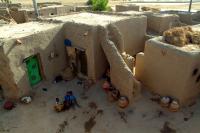 Dubbed the Venice of West Africa but Mopti has nothing of it. It is a typical dusty African town with uncountable one-storey mud houses and dirt streets.
Dubbed the Venice of West Africa but Mopti has nothing of it. It is a typical dusty African town with uncountable one-storey mud houses and dirt streets.
There are two big rivers (the Niger and the Bani, the Niger’s main tributary) and plenty of other water, which makes the town heaven for mosquitoes but hell for the people. The convergence of the Niger and the Bani is called the Niger Inland Delta, although it does not resemble a delta at all, however otherwise it is quite extraordinary.
My suspicion is that the delta should be contemplated from the air, best from a hot air balloon, since from land or water very little can be seen. I do not think that I need to mention that hot air balloon trips over Mopti are not on offer at any travel agent in Africa or anywhere else on this planet.
I struggled to enjoy myself in Mopti. Furthermore, my guide decided to take a break that day and asked his friend to take me on a tour in the town. He was so lazy! I realise it now.
His substitute did not know me and was speaking less than minimal English, making my non-existent French shine and sparkle in comparison. He annoyed me immensely when he took me to a market to visits his friends’ shops. I am so proud of myself that I did start to scream. I took it with the good ‘ole English stiff upper lip. With a face of stone I announced to all that I did not like their merchandise and explained that the quality was very poor. I was not lying. Unsurprisingly, the merchants could not argue about that.
Then, I was taken to the old district of Mopti. I actually did not dislike it. It offered an interesting architecture and a small mosque. I was also invited to climb one of the houses for a better view of the area. Of course, I had to pay for this privilege but I did not mind supporting the local people (picture below).
When I was walking around the houses, I had a terrible feeling that I was an intruder there. I was unsure whether I was entering people’s households or was it the people who were bringing their lives to the streets. Well, I was not entire comfortable with that situation, which was only contributing to my anxiety.
I nearly exploded when my substitute guide offered that I should go to the river to see fish. I had an interesting time explaining that I did see fish in my life before. I ended up laughing it over.
Although I had seen the Great Mosque in Djenne and some smaller mosques en route, I still found the Grande Mosque of Mopti interesting. It is obviously built in Sahel style. Whilst I was visiting, its façade was being repaired after the past rainy season. This operation was bringing the mosque’s full glory giving it smooth surface and fresh look.
The main gate to the mosque as well as the lower half of the temple were still waiting for their turn, which demonstrated the remarkable discrepancy between unrestored and restored façades. The restoration does make a massive difference.
In Mopti, I stayed at Hotel Fleuve in the new district of concrete built houses making an impression of a new district of any European city. The hotel had a nice rooftop but there was no worthy of note view. One could only ‘admire’ empty fields and construction sites for many other concrete houses. The river was nearby but it could not be seen due to large trees lined up along the riverbank.
The hotel was mediocre and overpriced. They do not give bed sheets so one has to have their own. My air conditioning did not work and the shower was rather dirty. It was on my list to stay there, but the travel guides, which mentioned the hotel did not specify how bad it was.
The Rough Guide to West Africa (one of my favourites in fact) actually says:
“Le Fleuve. Two pink new buildings behind Kanaga [really nice hotel on the river]. Good-sized self-contained rooms, most with air-conditioning. You can also sleep under the stars on the roof, next to a rooftop bar-restaurant with a fabulous view of the river”
I decided to stay in that hotel mainly because of the river view, which is not there! Can you see my disappointment?
|
Dec 27, 2004 07:00 PM Mali - Djenne
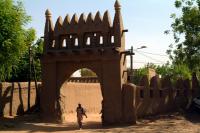 Djenne is said to be the most beautiful town in Mali and the entire Sahel. Well, it looks old and it is almost entirely made of mud or mud brick. It is a bit of a maze so it is easier with a guide at least for the first time.
Djenne is said to be the most beautiful town in Mali and the entire Sahel. Well, it looks old and it is almost entirely made of mud or mud brick. It is a bit of a maze so it is easier with a guide at least for the first time.
I had seen hundreds of pictures of Djenne before I went, and the vast majority of those photographs were of the famous mosque. This, unfortunately, created a picture in my head what to expect from this place. When I say unfortunately, I mean that I try not to put pictures of places in my head before I see them, to avoid eventual disappointment.
However, I am not actually sure that this statement is actually true, since I browse on the Internet a lot trying to see, which places I should visit. This inevitably means that I do put pictures of the places in my head and then subconsciously imagine what it would be like to be there. It is hard to seek photos of places one would love to visit without imagining what they look like in reality thus creating expectations.
What I am trying to say, so inarticulately, is that I try not to be too judgemental about places, which may slightly disappoint me or miss my expectations because I managed to develop them based on widely available photographs.
This is exactly what happened with Djenne. I am not saying that I was disappointed with the place, but I kind of expected a bit more. The mosque is truly magnificent and the town itself is utterly interesting with fabulous examples of Islamic or Sahel architecture and the maze of narrow streets. I suspect that my problem is that I did not spend enough time there and went on wandering around the maze only once.
I just thought that the famous mosque would be a little bit taller (it looks slightly taller on the pictures) and larger and that the town would be a little bit less neglected. The mosque’s façade was washed by the rains from the last rainy season and was still waiting for its new coat of mud. The surface was not smooth and therefore it did not look as majestic as it does on many photographs I have seen.
Do not get me wrong on this one – the mosque is impressive despite that it looks larger on pictures than it really is. I arrived around 1pm so the sun was too harsh to take pictures straight away upon arrival. Then, in the afternoon the sun was behind the mosque, which was not ideal either. The best light obviously is from the morning sun.
Inhabited since 250 B.C., Djenné became a market centre and an important link in the trans-Saharan gold trade. In the 15th and 16th centuries, it was one of the centres for the propagation of Islam. Its traditional houses, of which nearly 2,000 have survived, are built on hillocks (toguere) as protection from the seasonal floods.
The houses around the town are seriously remarkable with their traditional Islamic (Moroccan) windows. My guide explained to me that their shape was to prevent the public from seeing the women inside the houses. Women, according to the religion, tradition and culture, were not allowed to leave the house, so whenever they needed anything they had to ask for it from the windows.
It is in fact entirely Muslim town and obviously, nightlife is non-existent. That is strange because in other Muslim countries I have been to, there were soft drink bars where people hang around and socialised.
Obviously, there is tea drinking that is a centre of socialising, which is also an important ritual. Its importance is almost religious.
It was in Djenne, when I realised how important tea drinking is and it was the first time I was formally invited to sit down with the men and chat. Although it was after sunset and the hours of darkness fell upon the town, tea can be drunk at any time of the day or night.
Since I am not a ritual tea drinker, I was looking for alternative forms of entertainment and I would not mind to go and disco or club somewhere. I could not find anything like that. My guide did not know and the locals were not sure. Even cyber cafes were not open at night.
Fortunately, something was going on that night. It was a spectacle at La Maison des Jeunes (The House of Youths). The programme included traditional dancing in a form of a story without words. It was reasonably interesting and attracted a fair crowd – I was not surprised as there was nothing else going on in the town…
So, my guide bought us the tickets and we came inside to have a look. I did not enjoy myself for more than just ten minutes when a security guard approached my guide (Van) and asked for more money. It appeared that since the ticket for black people cost CFA100, white people had to pay ten times more. This did not go well with Van, who started arguing about this principle. He was actually ashamed to explain to me what happened and the situation was turning very nasty. Clearly, that was racism. I did not actually care about the price, but I agreed with Van that the principle was very wrong.
Since Van could not reach an agreement with them, the security demanded that we left. Obviously, Van did not want to do that and said that if he could not attend the show he needed to be fully refunded. Surprisingly they agreed to that and we collected our CFA200 from the booking office. I cannot say this was a pleasant episode of my holiday, but I can say that I do not care much about it anyway.
In order to calm Van down, we turned back to the hotel to have some more tea. It worked.
The tea-room (mind you, just a piece of dirt under the stars) was located next to two attention-grabbing shops offering various items of handcraft in a wide range. I was obviously interested in wood carvings, although I was being careful as I had yet thousands of kilometres to cover on this holiday. Therefore, I should not be buying much. There were two obvious reasons for that: a/ making my bag heavy to carry, b/ risk of damage during transportation.
Nevertheless, I decided (or rather was convinced) to acquire a few small wooden statues of people, mainly women. I was being selective trying to choose pretty ones, but also durable to minimise the risk of damage in transport. These two parameters were not always fully compatible however, and one of the statues I bought, actually my favourite, did break and I brought it home in three pieces.
Around Djenne, there are a number of pretty little villages – all with their own striking Sahel mosques, some of which are incredibly disproportionate to the size of the villages. The architecture of the villages is mixed and provide for a convenient overview of many styles present in Mali. Many of the villages, for example, have millet mud containers, which are so popular with the Dogons.
These villages set amid massive baobab trees are amongst the most memorable views I took home from my holiday in Mali.
|
Dec 26, 2004 07:00 PM Mali - Segou; day two
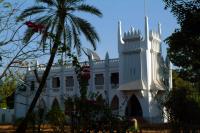 When the morning came, I wandered to both branches of the BDM bank. I was promptly faced with the fact that credit card machines did not work and with the alternative of possibly heading back to Bamako to use more reliable phone lines and cash dispensers in the ‘more reliable’ capital city.
When the morning came, I wandered to both branches of the BDM bank. I was promptly faced with the fact that credit card machines did not work and with the alternative of possibly heading back to Bamako to use more reliable phone lines and cash dispensers in the ‘more reliable’ capital city.
I had to sit down for a while and think if that was the alternative, I wanted to take. That would cost me going 500 kilometres in a wrong direction. Eventually, I decided to phone my mom in Poland to take some money out of my credit card and transfer it to Mali via Western Union.
To summarise the process – my mom withdrew some money from the cash machine in Ustka (Poland), some 5000 kilometres away from Segou (Mali), and went to the bank to process a virtual transaction on the global Western Union computer system. The money was immediately available for pick up in Segou.
That was only possible, because the computer in the BDM Bank in Segou was connected to the Western Union system, and they could see that the money was transferred. Strangely enough, they could not use the same method to see if I had enough limit on my credit card. That was strange, but hey – that is Africa, it is like that!
The most important outcome was that I did not have to waste time and money for going 500 kilometres in the wrong direction, and could make some more concrete plans for the rest of my holiday.
This was Monday – market day for Segou. It was a bit crazy and extremely overcrowded but colourful if a little bit odoriferous.
The most popular item being sold on the market was fish, in all forms, shapes, freshness, flavours and scents. There were a number of dried fish, which I saw in Senegal as well. That was the main source of the smell cruelly molesting the deep interior of my nose and brutally scratching my throat.
I have no idea how many people were trading there in Segou, along the Niger and in the nearby streets, but it was just too difficult to pas through. It was taking ten times longer to walk from the L’Esplanade to the Djoliba.
During the market day, I also noticed another aspect of life in Africa. It was the donkeys. Well, I spotted the donkeys several years before, but what I realised in Segou was how the donkeys were really treated. Those poor, extremely hard working donkeys were mercilessly beaten by their owners. They were beaten so hard on the back that each hit made a loud, terrible, deep sound of suffering and helpless body.
Many of the donkeys, which were working with the traders on the market had horrific, open wounds and were bleeding shockingly. I felt so sorry for them, because those poor creatures suffered terribly but were taking the abuse humbly, almost patiently, knowing that the beating will eventually stop at night. They did not cry. They were totally helpless being unable to say that they were hurt. I was hoping I would forget this very sad sight, but I actually could not.
Later that day, I went to explore the greener Segou a district between the centre and Segou-Koro. It is the area of many grand, Neo Sahel style colonial buildings erected among evergreen trees, which make Segou a truly great and magnificent city, yet underappreciated.
This part of the town is exceptionally elegant. The streets are clean and the buildings are kept in a good condition and look quite modern and comfortable. The area is calm and emanates something magical, and I have been struggling to express what it is. The sun sneaks in though the upper twigs of the trees creating multiple shadows on the ground.
I think this could actually be one of the best looking towns in West Africa that I have seen. At least this part of Segou easily competes with Bobo-Dioulasso and Saint-Louis. It arguably beats El-Jadida of Morocco, La Orotava of Tenerife and Swakopmund of Namibia on the African continent. I was genuinely impressed and could not believe that relatively so little people visit Segou.
The majority of the buildings provide accommodation for governmental and state institutions, like the police, the governor, hospital, etc. However, I noticed that several families were very fortunate to occupy some of the buildings as well. Their children were playing football among young birch trees, creating a picture, as it was taken from an illustration of a great novel about travel, adventure and discovery of new cultures.
Another striking part of Segou is the Niger riverfront. It is a solid, concrete promenade and a dyke protecting the town from flooding and providing the people with comfortable sidewalk right on the riverbank. This promenade is so unusual for Sahel countries. It impressed me. When I compared it with the riverfront of Saint-Louis in Senegal, where the banks were also strengthened with concrete, the one of Segou won easily.
The Senegal river is not as large and people’s attitude toward the environment and their town seemed much different, resulting in the riverbank to be polluted immensely making the walk along the river seriously unpleasant.
In Segou, the river bank is steep enough to isolate the people going about their business directly down on the riverbank from those relaxing up on the promenade. The promenade is simply missing a few little cafes or petit bars, where one can sit down and sip their drink or have a snack while watching the sun go down. That would make Segou the most attractive town in West Africa to unwind.
|
Dec 25, 2004 07:00 PM West Africa - Banjul (GM) to Bamako (ML) to Segou (ML)
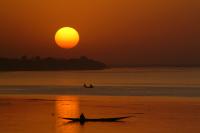 Although started in Bamako with a budget option and bought a bus ticket at the bus station, I soon learnt that I am not patient enough. I could not sit and wait for my bus all day and I eventually changed my mind and took a taxi all the way to Segou.
Although started in Bamako with a budget option and bought a bus ticket at the bus station, I soon learnt that I am not patient enough. I could not sit and wait for my bus all day and I eventually changed my mind and took a taxi all the way to Segou.
Well, the bus, which was supposed to depart hourly, never arrived on time and when it eventually turned up, my name was so down the list that I could not get on it at all. From my calculations I figured that it would take two busses before I would be read out from the list to board the bus, so I simply could not wait any longer. I already waited for three hours and since I did not have an unlimited time for my holiday, it was difficult for me to justify the sitting and waiting without seeing anything apart from a bus station.
I also knew that I was not planning to come back to Mali anytime soon, so obviously it made more sense to me to pay a little extra for the lift, so I could actually see something in Mali, given the tight timeframe. I did not actually see anything in Bamako. I was originally planning to spend a day there, however other things took priority and even the fact that I was short of cash, did not make me to come to the capital city.
People told me (both the tourists and the locals alike) that I should not regret that at all, because Bamako does not have anything particularly thrilling to offer.
I guess now I will not find out whether that was true or not unless I come back to Mali to check it.
|
Dec 25, 2004 07:00 PM Mali - Segou
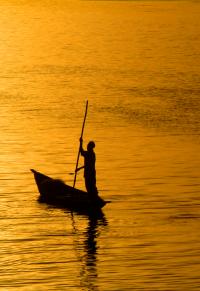 When I happily arrived in Segou, after rather uneventful two-hour-long drive, two of my original hotel choices, Hotel Djoliba and Hotel L’Auberge, did not have a room for me. I made an email booking at the Djoliba Hotel, but having not heard from them before I left home, I was not sure if they actually should have kept a room for me and whether I should argue or not. Subsequently, I found out that they should have and therefore I should have.
When I happily arrived in Segou, after rather uneventful two-hour-long drive, two of my original hotel choices, Hotel Djoliba and Hotel L’Auberge, did not have a room for me. I made an email booking at the Djoliba Hotel, but having not heard from them before I left home, I was not sure if they actually should have kept a room for me and whether I should argue or not. Subsequently, I found out that they should have and therefore I should have.
I was so lazy, that I did not even try to look in my guidebook if there was something else in the town that I could try. I was sensing that there should be but I was not sure how long it would take me to wander around and kept asking if there ware vacancies. I knew there were several options out of town.
The owner of L’Auberge scared me that the times were busy for hotels, and that I should rather start moving if I did not want to sleep in the street, which in fact is never the last option in Africa. It is always an option of a choice for the hard-core or rather silly travellers, but no-one is ever forced to sleep in the street due to an apparent lack of accommodation. One can sleep under the stars on the roof, for example or in a private home.
He eventually sent me to Hotel L'Esplanade right on the Niger River, and was actually kind enough to telephone them to find out if they had room for me.
It ultimately turned out that the hotels were not busy at all and Hotel L’Esplanade had plenty of rooms. They even asked me if I wanted an air-conditioned room or if a fan would suffice. I took the more expensive air-conditioned room. I was not impressed by the room at all, compared to the price I was paying for it – CFA 20,000 (£20). The sheets in the bed were not nice and the bathroom was faulty, with the toilet failing to flush. The air conditioning did not work either. But the fan did so I did not care that much.
I complained about the air conditioning and the receptionist came down to check if the device could be fixed but it could not. Yet, the hotel charged me the full amount for an AC room, rather than reducing the charge to the price of a room with a fan only. Something tells me that this all could be the reason why this hotel was not busy whilst others allegedly were struggling to accommodate travellers.
I would not recommend this hotel to anyone. The rooms are grotty and the staff is not necessarily helpful. There are extremely better value hotels in town than L’Esplanade. The Djoliba and L’Auberge are slightly cheaper (CFA 18,000) and their rooms are spotless, super comfortable with possibly the most modern bathrooms on the African continent.
After taking a shower, I went to see where I could have something to drink, because I was completely parched. Funny enough I had not eaten for two days and was not hungry at all. I had plenty of fresh juice though at Fajara beach in the Gambia from Solomon's Juice Bar.
Hotel L’Esplanade is running a bar at the river bank. It is actually a fine bar with an excellent location for river watching with all the action going on over there. it was also great for sunset, as there were benches outside. Unfortunately, they did not have large fridges and they were running out of cold drinks very quickly, often having no coke and no tonic. That is a bit unacceptable, but hey – that is Africa and it is like that (c’est comme ça).
I was sitting there sipping an unidentified soft drink made of, possibly, grapefruit, and talking to a local guide who wanted to do business with me. What he wanted to do was to show me the country – organise an itinerary. Well, I showed him my itinerary and categorically refused to pay CFA 990,000 for the pleasure of ‘holding my hand’ across Mali.
We spend almost two hours negotiating and when I eventually agreed to the price and the itinerary, I had revealed my problem of no cash on hand. So, I agreed to the trip provided I could draw cash on my credit card the following morning.
The sunset came and it was seriously immaculate. I am not sure if I ever saw a prettier one. It was unbelievable. The sun did truly look real – a giant fireball in the distance. It was fantastically three dimensional – not a simple flat circle in the sky but really a sphere descending inevitably into the slowly moving waters of the river. It was a superb picture.
I stood there on the riverbank completely hypnotised. I read about those fabulous sunsets on the Niger River, but having seen so many sunsets over water in my life, I was rather sceptical about the fabulousness of this one. I was wrong.
There was another element that kept magnetising tourists and me to the river. It was the people's silhouettes busy with their evening activities and long narrow fishing pirogues barely moving in the middle of this vast river. That was a dream come true scenery to any, even exceptionally demanding photographer. I almost fainted there!
After the sunset, I took a stroll around the town. I saw many people from the riverboats peacefully sleeping with their luggage on the riverbank under the stars, and the full moon covered them with a thin transparent silver blanket. I had a few ideas why those people were sleeping there, but they all proven to be incorrect. I thought they were waiting for their river connection or for the boat to continue taking them to their destination since navigating might have not been allowed in the night. They were simply hoping to be the first on the market the next morning. And they were the sellers and not the buyers.
|
Dec 24, 2004 07:00 PM The Gambia - Bakau, Senegambia
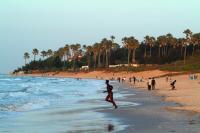 Bakau
Bakau
I cannot say that I visited Bakau. I went to Bakau. I never went there during daylight, and I could not see much in the hours of darkness, despite the fact that I spent there as much time as anywhere during daylight. Yes, I loved Bakau for its nightlife.
My two favourite places, names of which I remember (in fact I noted them in my mobile phone when there was still time to do so) were: Black Forest and Lama Lama. Both of them have two parts: the main sheltered bar area with the bar and the garden with tables and a stage.
In Lama Lama, where I went first, there was Joko Band playing, whose music was based on drumming accompanied with guitars. The place also boasted a decent restaurant with sophisticated dishes and extremely slow service. But this did not matter at all because the atmosphere, created by the live band and people enjoying it so much, dancing, hugging one another, and shouting in applause, was great.
At Black Forest, a different, and I dear say, a better band played - the 5 Star Band. It has a different climate there as well. The main bar area was nice and dark with side benches around. The open-air back garden was spacious but compact with nice, small tables around, and also high stools and long tables, which looked like bars. These bars faced the stage. The dancing area was also better, because it was more centred and people, mainly locals, had a great time and they were not hiding it.
I went to Bakau twice but unfortunately, I cannot remember the names of all the other bars and clubs. There were a few and I did a bar crawl one night with two local guys.
Senegambia
Somehow, I was trying to avoid going to the Senegambia area, where the expensive hotels are. I am not sure why. It never occurred to me that it could actually be a nice place to go out.
Ernest and Lamin took me there to go out on the Christmas Eve. I loved it. The place is not very African, which is therefore less atmospheric than Bakau, but it is well organised and there are many places to go out close to each other and the streets are well lit at night. It looks like a party strip in Tenerife on Canary Islands rather than in West Africa.
Until 2 am, I partied at Ali Baba’s Garden, which is a nice open-air garden restaurant and dance bar. Then, I concluded my night at the Wow! nightclub. It was so much fun!
|
Dec 23, 2004 07:00 PM The Gambia - Kotu, Fajara
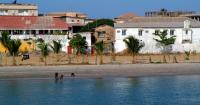 Kotu
Kotu
Kotu is a town adjacent to Serekunda, or actually part of the Serekunda conurbation. Maybe it should be described as a township rather than a town.
It is a place where clusters of single storey buildings made of wood, mud brick or corrugated iron are family homes. The streets are simple dirt tracks and life stock could be seen everywhere.
On a doorstep of one of the buildings, I saw a boy crying his eyes out. He was maybe four years old, and he was heart-breakingly crying aloud, completely losing his breath. Something utterly terrible and horrific must have happened to him. I feared that someone might have beaten him or even something worse. He told me that someone broke his wooden sling. He was holding the broken fork of the sling in his hand. He was so tremendously depressed that he was almost hypnotised.
My heart was breaking seeing this. It was obvious that he treasured this simple thing so much. I have never ever seen anything sadder than this. This one was the saddest beyond belief. There are not many toys available to the Gambian children, so even the simplest ones are cherished with tremendous passion and treated as priceless and completely irreplaceable treasure. I could not even begin to imagine what this little boy was going through.
I spotted a simple bush kiosk nearby, so I bought the boy a large bag of sweets and brought it to him. It was nothing special and I knew the sweets could not possibly replace his sling. He stopped crying and went home. I saw that he was a little bit happier, but I was happier a lot.
Later in Kotu, I stepped into a local bar with large long 1980's double cassette player – a real classic – playing reggae. There were three small, round, plastic white tables and a curly bartenderess with an attitude. I would not want to mess with her. One inebriated man (mind you, it was 13:00 hours – 1 pm) tried and he surely regretted it. I thought I was already playing with fire when I asked for… coca-cola.
Fajara
I stayed in Fajara’s Safari Garden Hotel, and I think I regretted a little bit that I picked it. It was nice and all, but packed with old and really boring people. I wanted to hang around with some young people. Only a lot later, I found out that the (more commercial) beachfront hotels are popular with young people.
The beach in Fajara was not bad with all crucial facilities to hang out and unwind. The hotels, and some of the beach restaurants would rent beach chairs and umbrellas. There are a few bars and also a nightclub – the Galaxy.
The beach in Fajara is the heart of life of the town. People play there on the beach, meet there, there is even a small market to do business. Also, some serious and impressive show off of local machos is on display. They mostly do push-ups but there is also some running and sit-ups.
From Lamin I heard that many guys regularly train and do weightlifting so they can be attractive to both the local and white women. The local women are said to be focused on material stability of eventual future family and then as a secondary aspect, they are maybe considering good looks. While white female tourist are most definitely turned on the looks.
So, since few local guys are rich, all of them make sure they can be attractive and many of them succeed very nicely. The muscle beach in Venice in Los Angeles looks pitiful compared to the beaches of The Gambia.
Football is the key game played on the beach. It is played with passion and… without any obvious rules.
Masseuses cruise the beach looking for business. I never knew, whether these were genuine or just a chat-up line to get you to bed.
|
Dec 22, 2004 07:00 PM The Gambia - Banjul, Barra, St James's Island
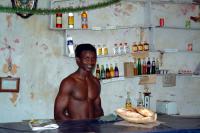 Banjul
Banjul
I so wanted to see the capital city, since it was said to have some interesting colonial architecture. I am not sure why I was imagining that should mean London-style architecture or the Victorian houses.
When I briefly visited Banjul, I found a dusty and uninspiring little town with reasonably decent beach. When in town, I did not even stick my camera out. I just did not know what to photograph. Falling apart buildings of concrete and steel were not necessarily worth the 4MB of memory in my camera’s flash card. I went to Banjul to cross the river and to withdraw some money. When I took 300 euro, I received several brick-size packs of the local paper money, which I struggled to hide in my pockets and camera bag.
Only when I stepped on the ferry, I saw the beach and some of the oceanfront.
Barra
Barra, at the other side of the river, was even worse. I was under the impression that the entire town was simply a big parking and warehouse place for the cargo vessels and vehicles. Ah, there was in fact a market there as well, but it was not particularly animated.
The most interesting part of the town was the beach and the harbour. I spent over an hour watching people working extremely hard at the shore carrying packages from dugouts to the pier. They had to go in the water reaching their chests and even shoulders. The packages, which were large, heavy sacks of rice, vegetables, flower, and other items, had to be carried on people’s heads for over twenty yards.
When the ferry from Barra to Banjul was about two hours late, I struggled to identify a local bar to sit down and have a coke, tonic or something. Luckily, I spotted the Barra Hotel, which I assumed would have a bar. It had.
The hotel was empty and so was the bar, but the bartender came and was happy to serve my guide and me. The bartender, named Sheku, owned also an Internet Café there on the hotel’s premises.
I might have spent an hour in the bar and during this time, I managed to have a short conversation with Sheku, visit his gym at the back of the hotel and tried some his weed, which he was so kind to share.
His gym was a rather simple single bench with some weights to lift, which could be adjusted. Nevertheless, his results were impressive. He was also good enough to let boys from the town use his gym for free.
James Island
To get to The Gambia’s only UNESCO listed site, the James Island, one needs to cross the river from south to north.
The ferry from Banjul is a simple open classic ferry construction. It makes the journey from one bank of the river Gambia to another taking as many passengers as it is possible to fit in the four passengers cabins, on walkways, stairways and main vehicle deck between the cars, motorbikes, trucks, cattle, sheep and goats. Or as many as can make it before the gap between the pier and the already departing boat is too wide to reasonably safely jump it across whilst carrying luggage, usually on the head.
Ship wrecks are Africa's standard element of the coastal landscape. Most of them sank as a result of, say, natural ageing process. The owners simply abandoned them there. African coastlines are serious vessels cemeteries polluting our decreasingly beautiful planet.
The road to the site is dusty and it leads through the bush. There are a few villages on the way and the landscape is nice. The soil is red and trees are tall.
James Island and Related Sites on the River Gambia, inscribed by UNESCO in 2003, present an exceptional testimony to the main periods and different facets of the encounter between Africa and Europe along the River Gambia, a continuum stretching from pre-colonial and pre-slavery times to independence. The site is particularly significant for its relation to the beginning of the slave trade and its abolition. It also documents early access to the interior of Africa.
James Island and Related Sites, the villages and the batteries, were directly and tangibly associated with the beginning and the conclusion of the slave trade, retaining its memory related to the African Diaspora. The River Gambia formed also an early corridor for the slave trade.
James Island today is a complete ruin as it has been for over a century since, as it is reported, gun powder exploded. The local guide, who so much wanted to accompany me to the island, had very limited knowledge of the place and his English was rather tiring. I could not listen to him anymore, to these inconsequential lies and discrepancies to spiced up history. For example, he told me that the dark food-store, the only complete surviving room in the complex, was the first slave dungeon. I just could not take this and I cut the visit short.
Juffureh
When I arrived to the site leading to James Island, I experienced two extremes. The village of Juffureh was the most fictitious of places I ever visited. It is packed with utterly distorted truth and bears no resemblance to history. A big tree in the central part of the village was the most significant finding of my trip, and genuinely true. Big trees in African villages have a few benches made of tree trunk around them, creating this way a cultural centre of the village.
|
Dec 21, 2004 07:00 PM The Gambia - Serekunda
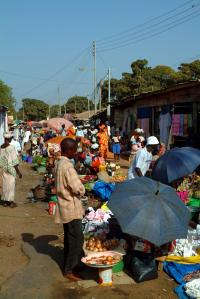 Last time I checked, The Gambia’s Gross National Product per head (or for more sophisticated people – ‘GDP per capita’) was just USD 310 (at the time of writing this was equal to GBP 155) annually, or to stimulate imagination – USD 25.83 (GBP 12.92) monthly. The Gambia’s annual GDP per capita is USD 10 higher than Burkina Faso’s, and USD 20 more than Mali’s, and USD 240 less than Senegal’s.
Last time I checked, The Gambia’s Gross National Product per head (or for more sophisticated people – ‘GDP per capita’) was just USD 310 (at the time of writing this was equal to GBP 155) annually, or to stimulate imagination – USD 25.83 (GBP 12.92) monthly. The Gambia’s annual GDP per capita is USD 10 higher than Burkina Faso’s, and USD 20 more than Mali’s, and USD 240 less than Senegal’s.
My point is that The Gambia has the least opportunity to grow their GDP, because the vast portion of the territory is a large river and the land around its waters is only good enough to grow peanuts.
The country’s magnificent beaches could contribute to the augment in the tourist industry, however overwhelming majority of the tourist arrive to The Gambia on charter flights with a packaged all-inclusive deal already paid for before landing in Africa. Those tourists are not very quick at spending any more money on the markets, restaurants, bars, etc. It is a shame, because there is no shortage of these facilities and their quality exceeds expectations.
It is an excellent holiday destination and I could emphasise enough how I would like to advertise it.
There are a number of qualities of The Gambia, like the ease to commute from one place to another. The country has an excellent climate and spectacular beaches on the fabulous Atlantic coast. The landscape is not overly sophisticated and there is not much of it, but the river is magnificent and the vegetation around it is lush. However, the main value of the country is the people.
The British pop group from the 1980’s – Wet Wet Wet, has also advertised The Gambia in some way when one of their videos was shot in The Gambia. I could not remember which song the video was for, and when I tried to find it on the Internet, I could not get on the right page, so after about ten minutes, I gave up. Later, I remembered that the song was titled “Sweet Little Mystery” and at the very beginning, the video features a boy, who says to the camera: ‘Welcome to Banjul, The Gambia’.
Serekunda is The Gambia’s largest city, which almost every visitor hits after landing. The Banjul International Airport, which has an impressive building from the outside, is actually located right outside Serekunda.
Oh, yeah – I just remembered that the taxi driver I took at the airport to take me to my hotel in Fajara had a car on its very last legs and there were no seatbelts. No seatbelts in Africa? Astoundingly, I was not petrified and not even surprised. He barely spoke any English as well.
So, after I landed in the hotel of my choice, and having had a nice hot shower, I took a local guide from the hotel for half-day, who took me to the real life of The Gambia. This way I managed to see the entire Serekunda conurbation. Most definitely, I would not be able to do it on my own.
I went to see the market, through which I simply flown, as I did not intend to buy anything disappointing absolutely every merchant.
I wanted to see the city, but I could not see much, because the buildings lined up along the road were blocking any panorama, and I forgot to tell the guide to take me high, so I could see something. I would have climbed a tree, had it been necessary. Basically, what I could see, can be seen on the photograph on this page. The buildings, or rather huts, are built of plank wood and corrugated iron without using any complex architectural concepts. The simpler, the better is the concept here. Oh, and cheaper!
Later, I was exposed to more of a centre of Serekunda, where the banks are. A few buildings there were new and endorsed the architectural model of using marble, steel and glass as the key elements of any construction.
That district of Serekunda is also the best place to go out at night. My favourite place was Jokor. It is a large, extremely popular nightclub with central open-air area surrounded by sheltered bars fronting small dancing areas. There are palm trees standing inside and around the premises making it a great and pleasant party place.
I went there on the ‘Girls Go Free’ night, which was an excellent choice. It was packed already by 23:30 hours (11:30 pm), which is rather early in Africa. I am saying it was an excellent choice, because it was so funny to see the girls’ desperation to hook up a white boy.
I was warned by a local boy not to speak to anybody in the club and definitely not to the girls. That was a weird advice, I have to say. What would be any other sensible purpose of going to a club? I said that he needn’t worry and that I could handle anybody in such situations.
I had numerous occasions to prove that. At some point, a girl (clearly a prostitute) asked if she could join my table. I said it was fine. She was drinking beer from a bottle. And there it goes – she says she wants to be my friend tonight. I had to reply that there are over six thousand million people on this planet and not everybody is going to be my friend. I explained that friendships develop over time and that it can take years.
I did not check AIDS statistics in The Gambia before I left, but I decided not to take any chances.
|
Page:
 90 91 92 93 94 95 96 97 98 99 100
90 91 92 93 94 95 96 97 98 99 100

|
|
|
